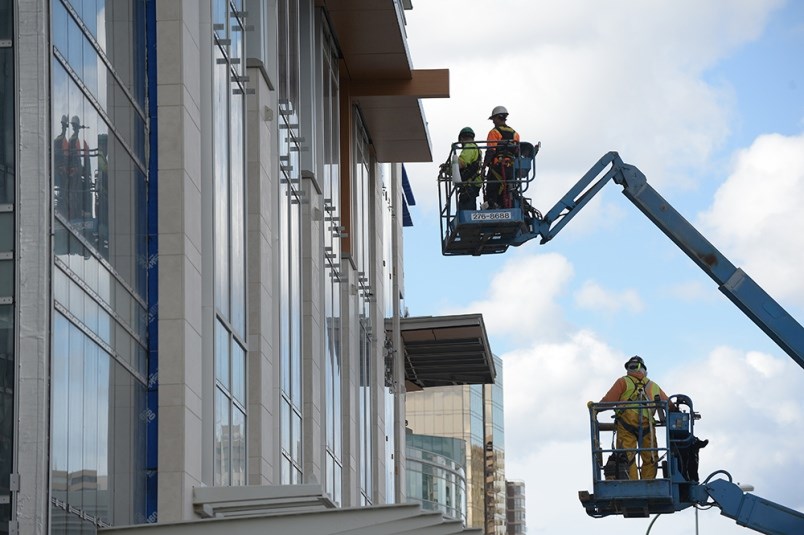Nearly half of Burnaby’s greenhouse gas emissions (GHG) come from people heating and cooling their homes and businesses, according to a city report.
With that in mind on Monday, city council set course for new rules governing energy efficiency in new buildings. The new policies laid out in the report could reduce GHG emissions by 70 per cent or more in new apartment, office and shopping developments, according to city staff.
“Buildings that use less resources, (while using) renewable energy systems and sustainable materials support a healthy environment,” wrote Lou Pelletier, Burnaby’s director of planning and building.
He said developments built after the rules come into effect will save money in the long run, by slashing heating bills, as well as create “green” jobs in the short term.
The new rules are expected to take effect July 1, 2019, after the city’s building bylaw is amended.
“This timeline is intended to give industry enough lead-time to prepare and adapt to new practices,” Pelletier wrote.
So what are the new rules?
The city is currently focusing on what the BC Building Code calls “Part 3” buildings – commercial buildings taller than three storeys or with a footprint larger than 600 square metres (6,458 sq. ft.) This includes “apartments, offices, shopping centres, hotels and some mixed-use buildings.”
The policy framework has five main components:
Energy modeling and airtightness testing
This policy would require developers to use software that predicts the energy use and GHG emissions of their planned “Part 3 “ buildings.
Once a building is nearly complete, builders would have to test it for airtightness.
“Achieving higher levels of energy efficiency requires more airtight buildings (while noting that fresh air is still delivered through efficient ventilation systems),” Pelletier’s report says.
Data from this testing would be used by the city to ensure developers are complying with the new rules.
More energy-efficient buildings
The city’s plan calls for standards capping overall energy use by the buildings in question. This gives flexibility to developers to implement the energy source that fits best, Pelletier wrote.
“However, this limitation may result in negligible or modest GHG reduction, depending on the type of fuel used for heating and cooling,” he wrote.
An apartment building could meet these efficiency standards while using natural gas, but would only see a 10 per cent reduction in GHG emissions, according to Pelletier’s report.
“For these reasons, Burnaby’s proposed green building policy for Part 3 buildings includes provisions to encourage the use of low carbon energy systems (LCES).”
Low-carbon energy systems
The city wants to see developers pursue the use of renewable energy to run their buildings’ heating, cooling and hot water.
“LCES technologies include, but are not limited to, air and ground source heat pump systems, waste heat recovery systems, biomass and solar energy systems, all of which have previously been implemented in Burnaby and neighbouring municipalities,” Pelletier wrote.
According to the report, both Brentwood Town Centre and Simon Fraser University already use such systems.
Flexibility to efficiency standards
To make way for the use of these systems, the city is prepared to relax its efficiency and airtightness standards. This will make implementing LCES more affordable and feasible for developers, according to the report.
This “flexibility” will make life easier for developers, according to Pelletier.
“For example, a particular site may be ideally suited to a geo-exchange system due to the geology. On another site, the designer may want to pursue an architectural design that lends itself more easily to a highly efficient building envelope.”
Monitor and report
Following the maxim “what gets measured gets managed,” this policy would require building owners to report energy use online to ensure they’re meeting Burnaby’s standards.
Burnaby’s green building future
The city plans to set these new rules in stone with the required bylaw amendments at future council meetings. Then, it will make sure developers, staff and the public are made aware of the policies before the targeted July implementation.
In early 2019, City staff and council plan to work on similar policies for “Part 9” buildings – low-rise apartments, single- and two-family homes.
And the municipality is already walking the talk. The Tommy Douglas Library is heated with geothermal energy, while the pool at Bonsor Recreation Centre is heated using solar energy. New city buildings will also have to adhere to any new rules passed by council, the report says.
Down the road, Pelletier wrote, the city will consider implementing energy efficiency retrofit standards for existing buildings.



